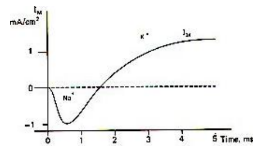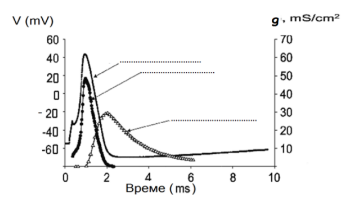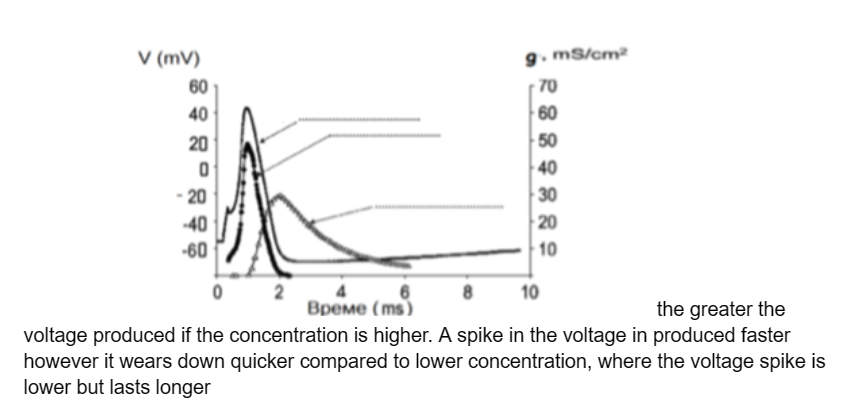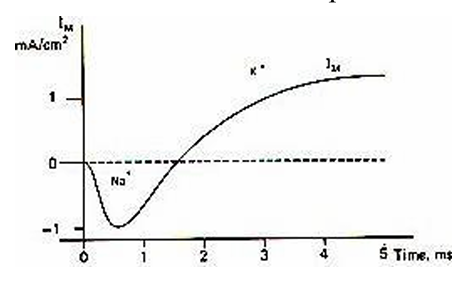Exercise 7. The Hodgkin and huxley model - ion theory of excitation. Method of the fixed voltage. Changes of the ion currents across the cell membrane of squid axon on blocking the Na+ and K+ channels
1/24
There's no tags or description
Looks like no tags are added yet.
Name | Mastery | Learn | Test | Matching | Spaced |
|---|
No study sessions yet.
25 Terms
266. Which of the following currents is responsible for the depolarization phase of the axonal action potential?
a) inward sodium ion current;
b) inward potassium ion current;
c) outward calcium ion current.
a) inward sodium ion current;
267. Which of the following currents is responsible for the repolarization phase of the axonal action potential?
a) inward sodium ion current;
b) inward calcium ion current;
c) outward potassium ion current.
c) outward potassium ion current.
268. Choose the correct statement:
a) action potentials propagate without attenuation (decrease) of amplitude and with relatives constant speed;
b) action potentials propagate with significant decrease of amplitude over the length of the membrane;
c) action potentials propagate with increase of the amplitude over the length of the membrane.
a) action potentials propagate without attenuation (decrease) of amplitude and with relative constant speed;
269. Which of the following factors affects the speed of propagation of axonal action potentials?
a) diameter and myelination;
b) only the diameter of the axon;
c) the length of the axon.
a) diameter and myelination;
270. Sodium equilibrium potential (ENa+) for typical neurons is about:
a) +45 mV;
b) - 90 mV;
c) +95 mV.
a) +45 mV;
271. The depolarization phase in typical neurons is due to:
a) Na+ ions;
b) Na+ and Ca2+ ions;
c) Ca2+ ions.
a) Na+ ions;
272. The equilibrium potential of which of the following ions is the closest to the membrane resting potential?
a) Na+ ;
b) Ca2+;
c) K+
c) K+
273. Treatment of tissue with tetrodotoxin (TTX) will result in:
a) change of the sodium equilibrium potential;
b) change in the extracellular sodium concentration;
c) inhibition of passive sodium transport.
c) inhibition of passive sodium transport.
TTX specifically blocks voltage-gated Na+ channels in excitable cells
274. Treatment of tissue with tetraethylammonium (TEA) will result in:
a) change of the potassium equilibrium potential;
b) inhibition of active potassium transport;
c) inhibition of passive potassium transport.
c) inhibition of passive potassium transport.
275. What makes the membrane resting potential so close to the potassium equilibrium potential?
a) leak potassium channels and low membrane permeability for other ions;
b) the much higher potassium concentration inside the cell compared to other ions;
c) the work of the sodium-potassium pump which balances the outward leak of potassium.
a) leak potassium channels and low membrane permeability for other ions;
leak potassium channels
constantly open
allow K+ ions to leak out of cell down their concentration gradient
membrane of resting neurons relatively impermeable to other ions eg Na+ or Cl-

276. What is represented on the graph on the right?
a) the evolution of total membrane current during the course of the action potential;
b) the inward Na+ current during the course of the action potential;
c) the outward K+ current during the course of the action potential.
a) the evolution of total membrane current during the course of the action potential;
277. For their experimental model Hodgkin and Huxley used the method of the:
a) generated voltage;
b) fixed voltage;
c) sinusoidal voltage.
b) fixed voltage;
performed experiments on giant squid axon using voltage clamp technique
method of fixing/ controlling the membrane potential (voltage) of the neuron at constant level
allowed them to study the ionic currents underlying the action potential
they manipulated the membrane potential then measured the resulting currents
278. The equation gNa = 1/RNa describes:
a) sodium membrane conductance;
b) sodium membrane current;
c) sodium membrane voltage.
a) sodium membrane conductance;
279. Membrane conductance for Na+ and K+ ions is not constant. It depends on:
a) the strength of the sub-threshold stimulus;
b) the state of the voltage-gated ion channels;
c) the state of the leak ion channels.
b) the state of the voltage-gated ion channels;
280. The depolarization phase of the axonal action potential is contributed to the:
a) inward Na+ current due to the electrogenic work of the sodium-potassium pump;
b) inward Na+ current due to the non-electrogenic work of the sodium-potassium pump;
c) inward Na+ current due to the activation of voltage-gated sodium channels.
c) inward Na+ current due to the activation of voltage-gated sodium channels.
281. The repolarization phase of the axonal action potential is contributed to:
a) the outward K+ current due to potassium leak channels;
b) the outward K+ current due to the activation of voltage-gated potassium channels;
c) the outward K+ current due to the electrogenic work of the sodium-potassium pump.
b) the outward K+ current due to the activation of voltage-gated potassium channels;
282. What happens when the membrane potential in neurons becomes equal or greater than the critical depolarisation threshold?
a) voltage gated Na+ channels become deactivated, and the membrane potential returns to its resting state;
b) voltage-gated Na+ channels do not respond to changes in the membrane potential reaching the critical threshold depolarization level;
c) voltage-gated Na+ channels open and action potential is initiated.
c) voltage-gated Na+ channels open and action potential is initiated.
283. What kind of ion current flows across the axonal membrane during the repolarization phase of the action potential?
a) negative Na+ current;
b) positive Na+ current;
c) positive K+ current.
c) positive K+ current.
positive because of K+ efflux
284. During the voltage clamp method, the voltage across the membrane is fixed and the current passing through the membrane is measured:
a) directly, using sensitive voltmeter across the membrane;
b) indirectly, by the input current required to keep the voltage fixed;
c) current is not measured but calculated using Ohm’s law.
b) indirectly, by the input current required to keep the voltage fixed;
285. During the resting state of the axonal membrane the ratio of the ion permeabilities for potassium and sodium is PK : PNa = 1 : 0.04. During the depolarization phase of the action potential this ratio changes as follows:
a) PK : PNa = 1 : 0.0004;
b) PK : PNa = 1 : 20;
c) PK : PNa = 20 : 0.04.
b) PK : PNa = 1 : 20;
286. A common property of “excitable" cells are:
a) the voltage-gated ion channels of the cellular membrane;
b) the Na+ /K+ pumps of the cellular membrane;
c) the membrane specialisation for communication via neurotransmitters and hormones.
a) the voltage-gated ion channels of the cellular membrane;
287. What type of ion current does not pass through membrane treated with 10-5 M of TEA (tetraethylammonium)?
a) Na+ influx;
b) Na+ efflux;
c) K+ efflux.
c) K+ efflux.
1. Sketch the evolution of Na+ and K+ ion currents during the course of the action potential (current vs time plot) when specific channels blockers such as TTX and TEA are applied.

2. Describe the plot below. Fill the missing information.
(top) action potential
(middle) Na+ conductance (Na+ channels)
(bottom) K+ conductance (K+ channels)

3. Sketch the evolution of the ion current during the course of the action potential (current vs time plot). Label the sketch.
